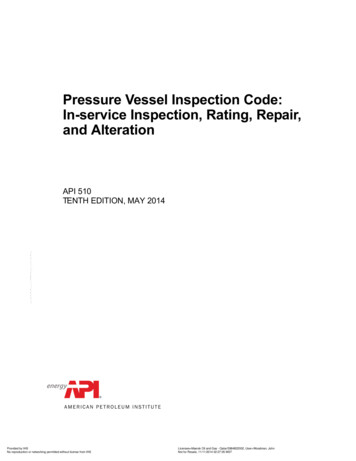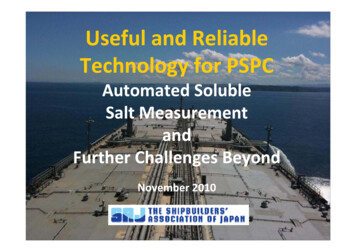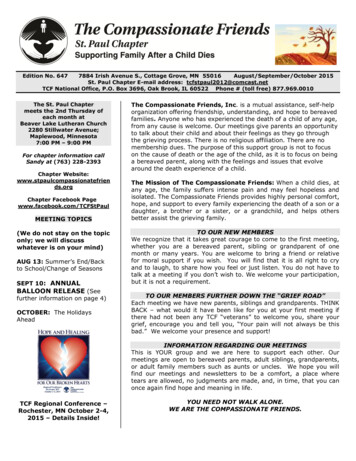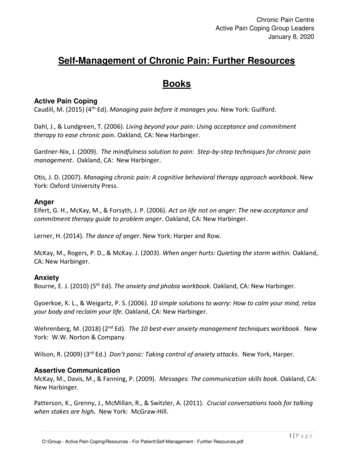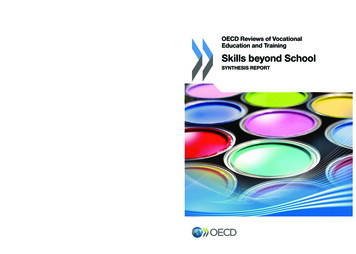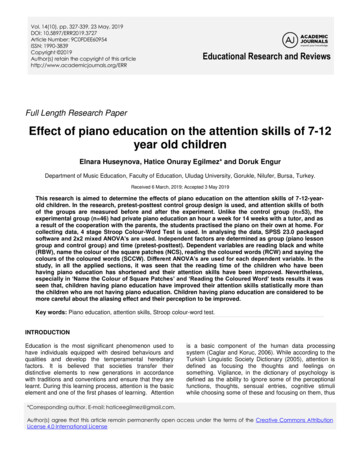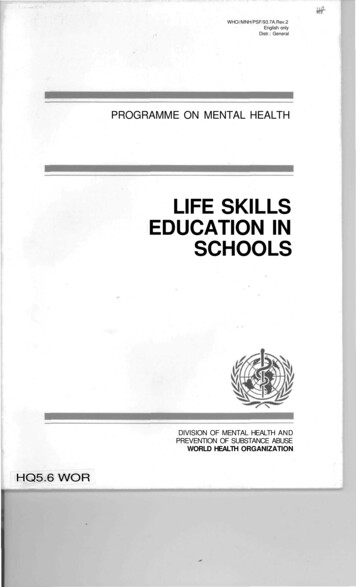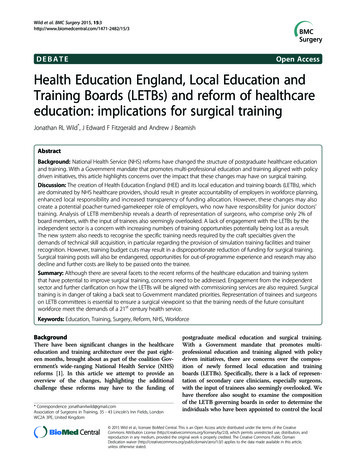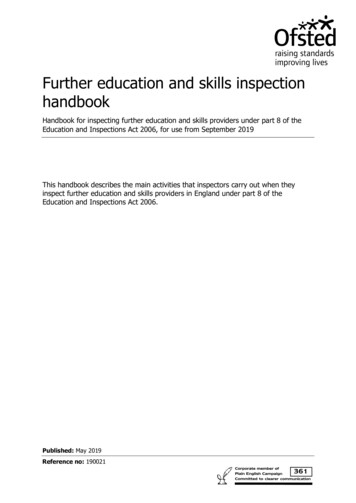
Transcription
Further education and skills inspectionhandbookHandbook for inspecting further education and skills providers under part 8 of theEducation and Inspections Act 2006, for use from September 2019This handbook describes the main activities that inspectors carry out when theyinspect further education and skills providers in England under part 8 of theEducation and Inspections Act 2006.Published: May 2019Reference no: 190021
ContentsIntroductionTypes of providers subject to inspection covered by this handbookPrivacy noticePart 1. How further education and skills providers will be inspectedBefore the inspectionFrequency of inspectionTypes of inspectionScope of inspectionBefore the inspectionPlanning for the inspectionDuring the inspectionAfter the inspectionQuality assurance and co1mplaintsShort inspections334556913151720262728Part 2. The evaluation schedule: how further education and skills providerswill be judgedBackground to the evaluation scheduleThe evaluation schedule and grade descriptorsEvaluating types of provisionQuality of educationBehaviour and attitudesPersonal developmentLeadership and managementFurther education and skills inspection handbookMay 2019, No. 19002135353538415053572
Introduction1.This handbook describes the main activities that inspectors carry out when theyinspect further education and skills providers in England under part 8 of theEducation and Inspections Act 2006. It sets out the evaluation criteria thatinspectors use to make their judgements and on which they report.2.The handbook has two parts: Part 1. How further education and skills providers will be inspectedThis contains information about the processes before, during and afterinspection. Part 2. The evaluation scheduleThis contains the evaluation criteria inspectors use to judge the quality andstandards of further education and skills providers and the main types ofevidence used.3.This handbook is a guide for inspectors on how to carry out inspections offurther education and skills providers. It is also available to providers and otherorganisations to inform them about inspection processes and procedures. Itbalances the need for consistent inspections with the need to respond to eachprovider’s individual circumstances. This handbook applies to inspections from 1September 2019 under the education inspection framework (EIF). 1 Inspectorswill apply their professional judgement when they use this handbook.Types of providers subject to inspection covered by thishandbook4.The providers we inspect under the Education and Inspections Act 2006 andusing this handbook are: further education colleges sixth-form colleges independent specialist colleges dance and drama colleges 2 independent learning providers local authority providers designated institutions 3‘Education inspection framework: draft for consultation’, Ofsted, January inspection-framework-draft-for-consultation.2Dance and drama colleges are inspected against the principles of the EIF at the request of the DfE.3Designated institutions have specially designated educational status under section 28 of the Furtherand Higher Education Act 1992.1Further education and skills inspection handbookMay 2019, No. 1900213
employer providers higher education institutions that provide further education and/orapprenticeship training up to level 5 16 to 19 academies/free schools.Privacy notice5.During an inspection, inspectors will collect information about staff and learnersby talking to them, by looking at documents, records and survey responses andother recorded information and by observing everyday life at the provider.Inspectors may also meet with employers where appropriate. Ofsted uses thisinformation to prepare its report and for the purposes set out in its privacypolicy. 4 We will not record names, but some of the information may make itpossible to identify an individual.6.Individuals and organisations have legal requirements to provide information toOfsted as part of inspections. Ofsted has legal powers under section 132 of theEducation and Inspections Act 2006 that relate to inspecting providers offurther education and skills for learners aged 16 and over. Inspectors can‘inspect, take copies of, or take away any documents relating to the educationor training’ of students from the provider’s premises. These powers also enableour inspectors to inspect computers and other devices that may hold thisinformation.Further education and skills: Ofsted privacy notice, -notice. Ofsted will not publish anyinformation that identifies an individual in the report but may name the principal, the chief executiveor equivalent.4Further education and skills inspection handbookMay 2019, No. 1900214
Part 1. How further education and skills providers willbe inspectedBefore the inspectionHow providers are selected for inspection7.To decide when we should next inspect a provider, we use the ‘frequencies ofinspection’ set out from page 6. We also use risk assessment to ensure that ourapproach to inspection is proportionate, so that we can focus our efforts wherewe can have the greatest impact.8.We use a broad range of information to assess risk and performance whenselecting providers for inspection. This process also applies in particular to goodor outstanding providers. The indicators include: previous inspection records self-assessment reports performance data destination data information provided, or concerns raised, by a funding body, governmentregulators, employers, parents and carers, and learners the views of learners, parents and carers, and employers, gatheredthrough online questionnaires relevant local intelligence, such as changes to leaders or structures any information about significant changes to the type of provision and thenumber of learners in a provider the size and complexity of a provider, including the number and types ofprovision, the geographical spread of education or training centres and anyrecent changes to these the outcomes of monitoring visits or any other related activity.9.We can use relevant information received at any point during the year to selectproviders. We will review this information regularly. 5‘Methodology note: risk assessment of good and outstanding further education and skills providers’,Ofsted, April 2018; skills-providers.5Further education and skills inspection handbookMay 2019, No. 1900215
Frequency of inspectionProviders judged outstanding10. Providers judged outstanding for overall effectiveness at their most recentinspection are not normally subject to routine inspection. 6 However, a providerjudged outstanding may receive a full inspection if its performance declines or ifthere is another compelling reason, such as potential safeguarding concerns. Aprovider judged as outstanding may also be inspected as part of our survey orresearch work, or through a monitoring visit.Providers judged good11. Providers judged good for overall effectiveness at their most recent inspectionwill usually be inspected within five years of the publication of their previousinspection report. This will normally be a short inspection but may be a fullinspection if information suggests that this is the most appropriate wayforward, for example, if the provider’s performance has declined. For moreinformation, see the section on short inspections (paragraphs 122 to 152). Agood provider may also be inspected as part of our survey or research work, orthrough a monitoring visit.Providers judged to require improvement12. Providers judged to require improvement at their most recent inspection willnormally receive a full inspection within 12 to 30 months of the publication theirprevious inspection report. These providers will normally be subject to amonitoring visit before the full re-inspection, normally seven to 13 months afterthe publication of their previous inspection report (see paragraph 32). 7Providers judged inadequate13. Providers judged inadequate will receive re-inspection monitoring visits, asoutlined in paragraphs 33 to 35. These providers will then receive a fullinspection (known as a ‘re-inspection’) within 15 months of publication of theirprevious full inspection report. The major exceptions to this are providers thatno longer receive their main funding or that have been removed from theRegister of Apprenticeship Training Providers (RoATP) and deliver onlyThe following types of providerare still subject to routine inspection when they have been judged tobe outstanding: higher education institutions offering further education and/or apprenticeship trainingup to level 5; local authority providers; independent specialist colleges. In these cases, they willnormally be inspected again within 6 years from the date of the publication of the report of theprevious inspection.7When a provider has been graded inadequate for apprenticeship provision and the provider has hadits apprenticeship funding terminated/ been removed from the register of apprenticeship trainingproviders, that apprenticeship provision will not normally be covered at the requires improvementmonitoring visit.6Further education and skills inspection handbookMay 2019, No. 1900216
apprenticeship provision. 8 From that point, neither a re-inspection monitoringvisit nor a full re-inspection will normally take place. If a provider hasapprenticeship provision graded inadequate and has also been removed fromthe RoATP, that apprenticeship provision will not normally be covered as part ofthe re-inspection monitoring visit and subsequent re-inspection.New providers14. We will normally carry out a monitoring visit to any provider that becomesnewly, directly and publicly funded to deliver education and/or training. 9 Thisfunding may either be received from the Education and Skills Funding Agency(ESFA) or through the apprenticeship levy. 10 The monitoring visit will normallytake place within 24 months of the provider starting to deliver directly fundedprovision. For more details about monitoring visits, see paragraphs 27 to 31.15. These providers will normally receive their first full inspection within 24 monthsof the publication of their monitoring visit report. 11 When a provider receivesone or more insufficient progress judgements at their monitoring visit, it willnormally receive a full inspection within six to 12 months of the publication ofthe monitoring visit report. We may carry out a full inspection of theseproviders without carrying out a monitoring visit, where appropriate. 1216. If a provider has made insufficient progress in safeguarding, it will normallyreceive one further monitoring visit to review only its safeguardingarrangements within four months of the publication date of its previousmonitoring visit report. 13See also ESFA guidance, ‘Removal from register of apprenticeship training viders.9This relates to providers newly and directly funded to deliver apprenticeship provision from or afterApril 2017 (whether levy or non-levy) and those which are newly funded to deliver education provisionfrom or after August 2017 whether, adult education, 16 to 19 study programme or high needs funded.10‘Apprenticeship funding: how it works’, Department for Education, it-will-work.11New FE colleges and 16 to 19 academies that began to deliver funded provision from August/September 2017 will receive their full inspection in their third year, in accordance with pre-existingarrangements. They will not normally receive a monitoring visit.12However, new providers that became newly directly funded for apprenticeship provision before April2017 or other forms of funding before August 2017 and that have not yet received their first fullinspection will usually receive a full inspection directly.13If the provider’s only insufficient progress judgement relates to safeguarding and it then receives ajudgement of reasonable or significant progress with respect to safeguarding at the secondmonitoring visit, the provider will not then have a judgement of insufficient progress. The fullinspection will then take place within 24 months of the publication of the first monitoring visit report.8Further education and skills inspection handbookMay 2019, No. 1900217
Newly merged colleges17. A newly merged college will normally receive a full inspection within three yearsof the merger. This will normally be a full inspection. For inspection purposes,regardless of the type of merger, we view all merged colleges as newcolleges. 14 A newly merged college will not carry forward any inspection gradesfrom predecessor colleges. It will have no inspection grade until the first fullinspection.18. Any newly merged college may receive a monitoring visit at any reasonabletime. A newly merged college will normally receive a monitoring visit before thefirst full inspection if the overall effectiveness grade of one or more of thepredecessor colleges was requires improvement or inadequate. 15 Thesemonitoring visits will focus on relevant themes about the progress of themerged college, including from the most recent report(s) of the predecessorcollege(s). Monitoring visits will normally arrive at progress judgements againstthese themes as set out in paragraph 25. The monitoring visit report willnormally be published. Concerns about risks arising from this or other sourcesmay lead to an earlier full inspection within the three-year window. 16Sixth-form colleges that convert to become 16 to 19 academies19. Sixth-form colleges that convert to become 16 to 19 academies will be treatedaccording to their
This handbook describes the main activities that inspectors carry out when they inspect further education and skills providers in England under part 8 of the Education and Inspections Act 2006. It sets out the evaluation criteria that inspectors use to make their judgements and on which they report. 2. The handbook has two parts: Part 1. How further education and skills providers will be .File Size: 625KBPage Count: 63
